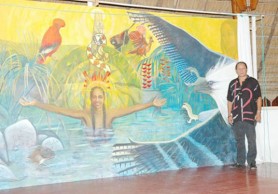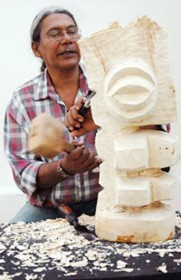Among the most exciting developments in Guyanese art over the past quarter of a century has been the significant rise of Amerindian art. It is not that it had no real presence or recognition before that, but that certain factors drove it into prominence, and a number of important new directions in the artists’ preoccupations caused Amerindian art to come into its own and make a resounding impact over the last twenty years or so.


To further support what the artists were saying about Meaning in Amerindian Art, the gallery put on show some of the work by Stephanie Correia, Marjorie Broodhagen, Edward Fredericks, Roaland Taylor, Anil Roberts, Valentine Stoll, along with Simon, Hussein and Craig. This work comprises only a few pieces and a relatively small portion of what is in the National Collection and what exists elsewhere, but was in very particular ways representative of the images which are informed by and which communicate this ‘meaning.’ These images and this meaning help to create the excitement in the art and lend a strength to Guyanese work that gives it some ascendancy in Caribbean fine arts.
Yet, there is no homogeneity, as is illustrated in the personal influences behind the output of the three leading personalities, Craig, Hussein and Simon. Among the most fascinating energies that have fired this art since the 1980s is the vibrant influence of myth, the spiritual, the indigenous and the traditional. In studying the meaning, therefore, one might just tend to look for these in the work in a fairly uniform way. But while those influences are important in most of the work, there are interesting differences among these three. Hussein is the most deeply intuitive, for whom self, spirit, art and environment are one. He lives directly with nature and his work manifests an inner spirit.
Craig is almost an opposite; although he grew up in the forest environment and was nurtured by it, his work does not specifically reflect Amerindianness. It reflects what he sees as all humanity. Simon has immersed himself in spirituality and has even undertaken his own Shamanistic journey through England, Sudan, Chad and Haiti. He has studied the traditions but he has also researched the myths, religion and culture of others and has become interested in transformations. His work is the result of intense and extensive study.

Looking back at the history of Amerindians and art in Guyana, one finds archival pieces; several drawings, paintings and pictures of Amerindians in traditional settings, giving an impression of artists and travellers’ interest in romanticism, if not exoticism. Added to that is, of course, anthropological documentation. There is also pre-history, and the still physical presence of petroglyphs which, further to that, have been a major source of influence for the use of Amerindian motifs in modern art.
That was certainly strong in artists who were Amerindians, such as Stephanie Correia, who used them in ceramics and then explored mythical material in paintings. But the strongest explorer of these motifs was not Amerindian at all, but foremost Guyanese painter Aubrey Williams. Another of the most prominent Guyanese artists for decades before 1990 was Marjorie Broodhagen of Dutch and Amerindian ancestry who used motifs and created a famous tapestry owned by the University of Guyana, but who also had other wide interests. And then there was the real serious rise of the distinctive features of Amerindian art which started in the 1980s.
There were important contributory factors to this rise. One of these had to be George Simon, whose work was already on the highest levels of national art by that time, but whose interests in mythology, spirituality and indigenous traditions deepened and even exploded after that period.
Another factor was the emergence of his brother Oswald Hussein, who rocketed to national prominence with the discovery of the sheer power, the excellence and uniqueness of his sculpture in the late 1980s. He made the greatest impact registered by any one individual and rocked the exhibition halls with startling pieces not seen before, winning the major prizes in the national exhibitions. The other major impact made by an individual was Winslow Craig’s arrival in the 1990s when he moved out of art school straight into the most hallowed corridors of national art because of his excellence and outstanding presence.





